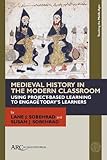Medieval History in the Modern Classroom : Using Project-Based Learning to Engage Today’s Learners / Susan J. Sobehrad, Lane J. Sobehrad.
Material type: TextSeries: Teaching the Middle AgesPublisher: Leeds : ARC Humanities Press, [2022]Copyright date: ©2022Description: 1 online resource (240 p.)Content type:
TextSeries: Teaching the Middle AgesPublisher: Leeds : ARC Humanities Press, [2022]Copyright date: ©2022Description: 1 online resource (240 p.)Content type: - 9781802700329
- 907.1/1 23/eng/20220610
- D16.2 .S63 2022
- online - DeGruyter
| Item type | Current library | Call number | URL | Status | Notes | Barcode | |
|---|---|---|---|---|---|---|---|
 eBook
eBook
|
Biblioteca "Angelicum" Pont. Univ. S.Tommaso d'Aquino Nuvola online | online - DeGruyter (Browse shelf(Opens below)) | Online access | Not for loan (Accesso limitato) | Accesso per gli utenti autorizzati / Access for authorized users | (dgr)9781802700329 |
Frontmatter -- CONTENTS -- LIST OF ILLUSTRATIONS -- PREFACE -- Chapter 1. CHANGING PERCEPTIONS IN TEACHING MEDIEVAL HISTORY -- Chapter 2. MEDIEVAL HISTORY COURSE DESIGN -- Chapter 3. ACTIVE CONSTRUCTION OF KNOWLEDGE AND INTENTIONAL PLANNING -- Chapter 4. PROJECT MANAGEMENT -- Chapter 5. TECHNOLOGY IN THE MEDIEVAL-HISTORY CLASSROOM -- Chapter 6. MEDIEVAL STUDIES PROJECT EXAMPLES -- EPILOGUE -- Appendix A. HISTORICAL STANDARDS -- Appendix B. SAMPLE CONTENT AND SKILL RUBRICS -- Appendix C. PLANNING AND IMPLEMENTATION TOOLS -- Appendix D. SURVEY OF UNDERGRADUATE MEDIEVAL HISTORY COURSES IN US COLLEGES AND UNIVERSITIES -- INDEX
restricted access online access with authorization star
http://purl.org/coar/access_right/c_16ec
Teaching medieval history should engage students in the real work of professional medievalists. However, many undergraduate courses rely on instructional strategies that only engage students in rote retention of medieval "stuff" and unsupported writing assignments. With trends in the USA and elsewhere showing declining undergraduate enrollment in the humanities and an increasing number of questions from university administrators regarding the utility of the liberal arts, historians need to reassess how they teach. Project-based learning (PBL) is one approach that may help medieval history instructors offer coursework that is more engaging for today's undergraduate students and provide administrators a clearer picture of the utility of studying the past. The pedagogy of PBL actively engages students in projects reflective of the real work being done by medievalists, allowing instructors to move beyond the traditional narrative found in many undergraduate survey courses. This book provides an overview of PBL theory, methods for incorporating PBL into an undergraduate medieval history course, instructional strategies, scalable assessment formats, and other resources useful for any history classroom.
Mode of access: Internet via World Wide Web.
In English.
Description based on online resource; title from PDF title page (publisher's Web site, viewed 01. Dez 2022)


